Is exercise or fitness your passion? Or do you have a good understanding of gym equipment and workout routines?
If yes, you might have considered having your own gym at some point. After all, who doesn’t want to turn their passion into a profession?
And guess what! Just like you wouldn’t hit the gym without a workout plan, starting your own gym demands a comprehensive gym business plan!
If you’re seeking investors to kickstart a new fitness center or aiming to expand an existing gym business, a modern business plan is an essential tool.
A well-written gym business plan will help you pay attention to every detail, and support your entrepreneurial journey to make the best strategies for a profitable business.
But before diving right into the detailed gym business plan; let’s check out some interesting facts about the fitness industry.
Fitness Industry Outlook
- The growing enthusiasm for fitness and the desire for a healthy lifestyle has led to the demand for gyms. As of now, 39% of Americans have gym memberships.
- The fitness industry has been booming in recent years, and it is expected to have 230 million members by 2030.
- The Health and fitness market revenue is estimated to grow at a rate of 11.52% annually, reaching a market volume of US$2.32 billion by 2027.
- The fitness industry is expected to increase its revenue by 172% from 2021 to 2028 – reaching $435 billion.
- From 2011 to 2019, the revenue for gyms and health centers in the United States consistently increased each year.
- Recently, the United States led the world in gym industry revenue and is expected to add 15.6 million more members by 2030.
Now that you know the fitness industry outlook, it’s time to explore all the key components you will need to include in your professional gym business plan outline:
Key Components of a Gym Business Plan (w/ Examples)
1. Executive Summary
The executive summary is the first and foremost section of the business plan. Generally, it is a quick overview of your entire gym business plan.
It should be clear, concise, and engaging as it will create your first impression and draw readers to delve further into your plan.
You can start this section with a brief introduction to your gym business and discuss the following key elements:
- Market Opportunity
- Vision & mission statement
- Target market
- Your products and services
- Marketing strategy
- Management team
- Financial Outlook
After that, end your summary with a clear call to action to invite potential investors or readers to the next meeting.
Say goodbye to boring templates
Build your business plan faster and easier with AI
Plans starting from $14/month

2. Company Overview
The company overview section provides a more detailed description of your gym business.
It includes the legal structure, location, ownership, critical success factors, business history, and everything about your business.
First, provide the basic details of your gym including what is the name and what type of gym you are operating.
Mention the names of your gym owners/partners along with the qualifications. You can also include the business history(if any) and milestones you have achieved.
After that, describe your business goals to convey a high level of aspirations and vision that you want to achieve. Here is an example, describing the business goals and objectives:
Setting future business goals for a gym is a crucial step in outlining a clear path to achieve success and growth. The Stayfit Company’s goals and objectives include;
- Increase the client base by 100 customers within the first year of operation.
- Relocating to a large and more appropriate location facility by the first year of operation.
- Expand service offerings to provide a comprehensive fitness experience.
- Establish partnerships and increase brand visibility to become a recognized fitness brand in the community.
- Increase total memberships to 500 within 5 years.
Remember, this section gives an in-depth understanding of your business and business owners. So, make it clear and intriguing.
3. Industry and Customer Analysis
In the industry and customer analysis section of your gym business plan, it’s necessary to offer a comprehensive overview of the fitness industry and target market.
This section gives you a deep understanding of your industry and target customer attributes which will help you in business planning.
Here are some questions that will help you in the analysis:
- What is the current market size of the fitness industry in terms of revenue?
- What are the current trends in the gym business?
- Who are the target audience, and which customer segment do you wish to serve?
- What is the growth forecast for the gym business?
For example, look at this market segment and target market of the gym business with the help of Upmetrics:
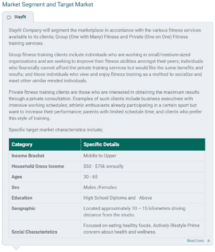
As a gym owner, you can target the following customer profiles:
- Blue-collar employees (factories, warehouses, service industry)
- White-collar individuals(corporate or government employees)
- Retirees
- High school & college students
- Military members and their families
- Athletes who often train for fitness competitions
In short, a thorough industry analysis will educate you about the local market and help you prepare marketing strategies according to the market trends.
4. Competitor Analysis
This competitor analysis will help you understand the top competitors and identify the strong points of their service offerings.
As a gym business, you should make a list of the number of gyms or other fitness businesses operating in your locality, their size, and their customer base. Try to specify who are your direct and indirect competitors.
- Direct competitors can be other local gyms
- Indirect competitors can be another type of gym or fitness center, or health club in your area.
Now, let’s focus on your direct competitors and provide an overview of each competitor, including their size and where they’re based. Evaluate their strengths and weaknesses including their service offerings and pricing structures.
Refer below example; showing competitor analysis description:
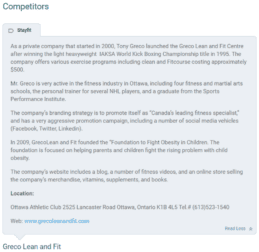
A better way to conduct this analysis is by noticing things from a customer’s perspective. You might even ask your competitors’ clients what they like or dislike about them to get valuable insights.
This way you can understand what makes your competitors successful and what gaps you can fill. Also, consider the unique selling proposition of your gym business.
Specify your tactics to stay ahead in the competitive landscape and make all the difference in the local gym market.
5. Service Offerings
Next, specify the scope of your service offerings and elucidate how they meet the diverse needs of your clientele.
This section must be informative, precise, and client-focused, as it is a detailed breakdown of what your fitness business offers your customers.
You can include a comprehensive suite of services encompassing types of membership options, available exercise equipment, personal training sessions, group fitness classes, or nutritional counseling.
Here, you can take a reference from the below example written using Upmetrics AI Assistant:
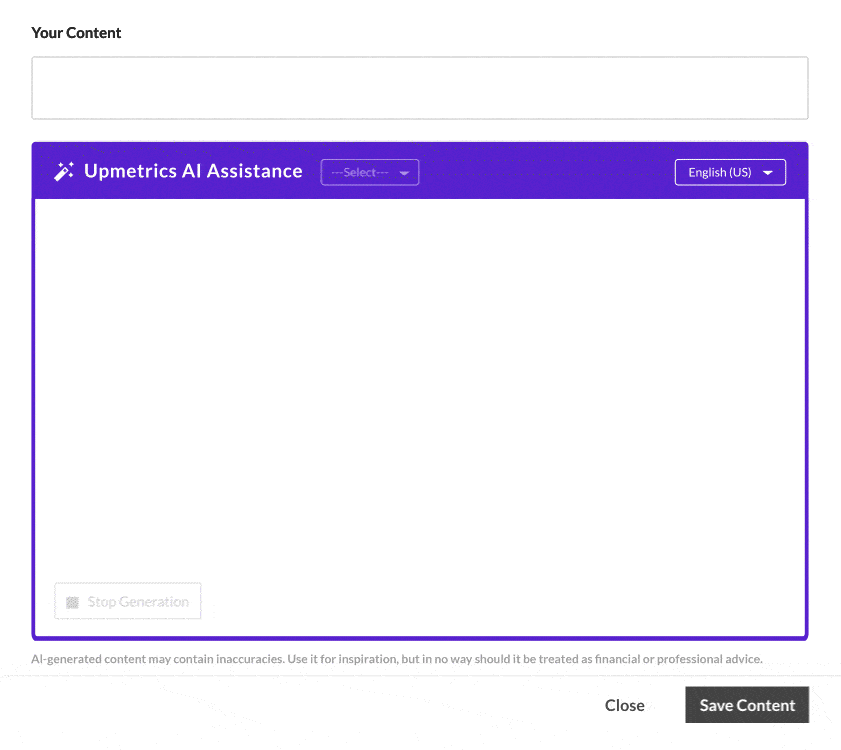
Also, detail any membership fees or pricing plans in this section to add or revise services. Mention if your gym provides any additional services, like physical therapy, massage therapy, recovery modalities, etc.
6. Marketing Strategy
Writing the sales and marketing plan section means jotting down all the customer acquisition strategies and the tactics for how to retain them.
You can consider the following marketing approaches to gaining and keeping customers for your new gym business:
Unique Selling Proposition
Define your gym’s USPs depending on the market you serve, the gym equipment you use, and the unique services you provide. Highlight certified gym trainers, specialty programs, and regular community events.
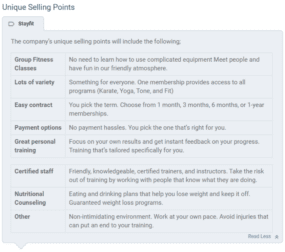
Social media marketing
Use social media platforms to attract more users. Create engaging content and entice your audience with inspirational posts and special offers. Connect with your customers digitally as well as in the gym.
Branding
Establish a professional website and brand symbol (gym’s logo) to reach a wider audience. Showcase all your service offerings and build trust among potential customers.
Loyalty plans
Consider loyalty plans to retain existing gym members and encourage long-term commitment. Create membership tiers or referral programs to offer discounts or additional benefits.
Collaborations
Partner with local businesses (health food stores, fitness centers, or clothing brands), and fitness influencers to cross-promote services or offer collaborative discounts. That can expand your gym’s reach and draw a broader audience.
Offline advertising
Traditional offline marketing can still be effective in engaging with your local community. Clearly state your advertising strategies, including open bulletin boards, print marketing, flier distributions, or community events. For instance,
Consider following offline advertising strategies to reach specific demographics:
- Local Print Media: Advertise in local newspapers, magazines, or community newsletters to target residents in your area.
- Flier Distribution: Distribute flyers or brochures in strategic locations such as community centers, local cafes, or residential areas to raise awareness about your gym.
- Community Events: Sponsor or participate in community events, fairs, or health expos. This not only promotes your gym but also allows for direct interaction with potential members.
Pricing strategy
Try to develop detailed strategies, like offering special introductory discounts, free trials, seasonal promotions, or membership packages with additional services to attract and retain members.
7. Management Team
A strong management team is essential to showcase your gym’s ability to thrive in the industry. This management team section emphasizes the key members who can help grow your fitness business.
You can highlight your key managers, fitness experts, personal trainers, or nutritionists. Also, explain each member’s expertise and roles.
Also, discuss the compensation plan in this section, along with their salaries, incentives, and other benefits. For instance,
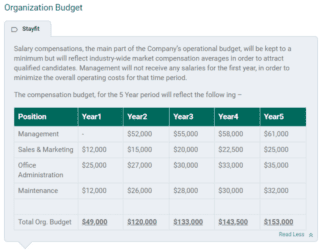
8. Operations Plan
This operations plan is like a map that shows how you will make your business work.
It provides detailed insights into the day-to-day operations of your gym and highlights key areas such as staffing and operational processes.
Consider adding below essential components to your operational plan:
Staffing
Try to mention the number of trainers, support staff, and therapists needed. Briefly outline the duties they will perform and detail their qualifications & training required.
Operational Process
Summarize the processes and techniques you will use to run your gym. Your operational process section may include hosting fitness classes, assigning trainers, scheduling the group HIIT classes, billing, training staff, etc.
Equipment & Machinery
You can include the list of gym equipment and machinery required for the gym, such as strength training equipment, pull-up bars, cardio equipment, free weights/dumbbells, and aerobic equipment.
Refer to the below example written using our AI assistant:
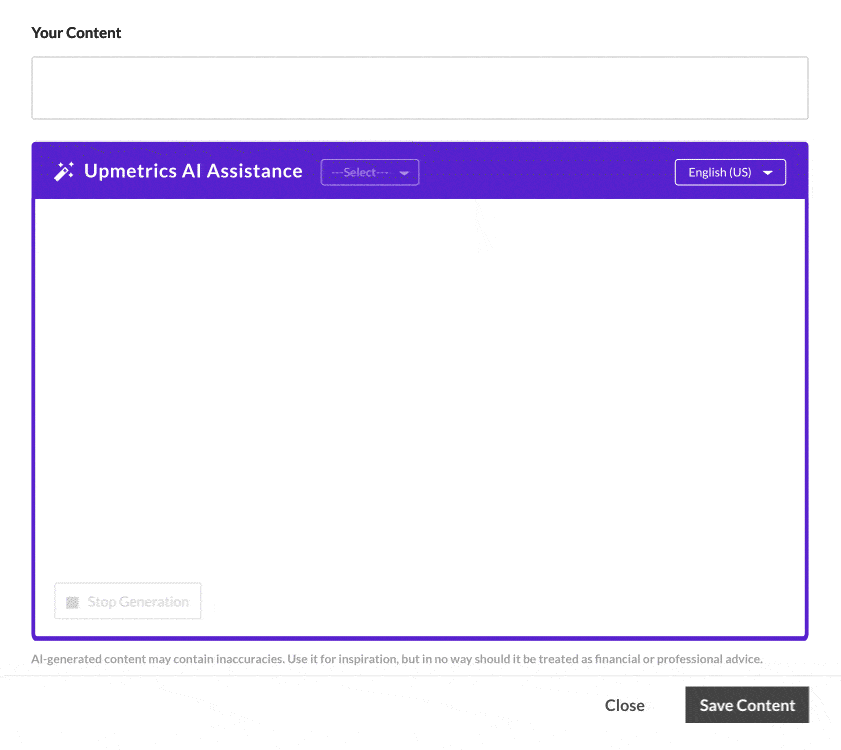
9. Financial Plan
Presently, you are in the business planning phase, but devoting some time to putting together the most realistic financial projections is also crucial when you start seeking funding from investors.
It is a detailed blueprint of all the cash flow and revenue streams, initial startup costs for setting up your gym and equipment, profit margins, and operational costs.
So, mention all the below elements in your gym business plan outline:
- Profit and loss statement
- Cash flow statement
- Balance sheet
- Break-even analysis
- Business ratios
- Exit strategy
This financial forecast has a substantial value in terms of whether you secure funding or not. And evaluate the funding resources, including bank loans, SBA-guaranteed loans, crowdfunding, or personal savings.
Here’s an example of a projected P&L statement for a gym financial plan with the help of Upmetrics:

Download Free Gym Business Plan PDF
Need help writing your gym business plan from scratch? Well, here you go; download our free gym business plan pdf now and start writing.
This modern, user-friendly business plan template is specifically designed for your gym business.
With a step-by-step guide and example, it helps you write a solid gym business plan without missing any crucial steps.
The Quickest Way to turn a Business Idea into a Business Plan
Fill-in-the-blanks and automatic financials make it easy.
Start Drafting Your Plan with Upmetrics
With Upmetrics, you will get easy-to-follow steps, 400+ sample business plans, and AI support to streamline your business planning approach.
Our financial forecasting tool will help you develop accurate financial forecasts for 3 or more years if you’re not great with financial formulas.
Whether you’re venturing into a new business or aiming for expansion, Upmetrics provides valuable resources and insights to build successful and professional business plans that perfectly align with your objectives.
So, don’t wait; start planning now!




